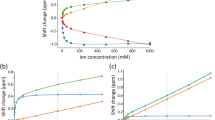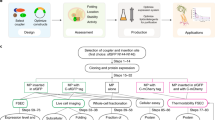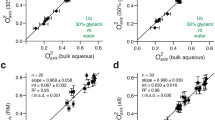Abstract
This review deals with ways of stabilizing proteins against aggregation and with methods to determine, predict, and increase solubility. Solvent additives (osmolytes) that stabilize proteins are listed with a description of their effects on proteins and on the solvation properties of water. Special attention is given to areas where solubility limitations pose major problems, as in the preparation of highly concentrated solutions of recombinant proteins for structural determination with NMR and X-ray crystallography, refolding of inclusion body proteins, studies of membrane protein dynamics, and in the formulation of proteins for pharmaceutical use. Structural factors relating to solubility and possibilities for protein engineering are analyzed.
This is a preview of subscription content, access via your institution
Access options
Subscribe to this journal
Receive 12 print issues and online access
$259.00 per year
only $21.58 per issue
Buy this article
- Purchase on SpringerLink
- Instant access to full article PDF
Prices may be subject to local taxes which are calculated during checkout
Similar content being viewed by others
References
Markussen, J., Diers, I., Hougaard, P., Langkjaer, L., Norris, K., Snel, L., Sørensen, A.R., Sørensen, E. and Voigt, H.O., 1988. Soluble, prolonged-acting insulin derivatives. III. Degree of protraction, crystallizability, and chemical stability of insulins substituted in positions A21, B13, B23, B27 and B30. Protein Engineering 2: 157–166.
Dinnbier, U., Limpinsel, E., Schmid, R. and Bakker, E.P. 1988. Transient accumulation of potassium glutamate and its replacement by trehalose during adaptation of growing cells of Escherichia coli K-12 to elevated sodium chloride concentrations. Arch. Microbiol. 150: 348–357.
Mitchell, R.D., Simmerman, H.K.B. and Jones, L.R. 1988. Ca2+ binding effects on protein conformation and protein interactions of canine cardiac calsequestrin. J. Biol. Chem. 263: 1376–1381.
Farrell, H.M., Kumosinski, T.F., Pulaski, P. and Thompson, M.P. 1988. Calcium-induced associations of the caseins: a thermodynamic linkage approach to precipitation and resolubilization. Arch. Biochem. Biophys. 265: 146–158.
Robinson, J.J. 1988. Roles for Ca2+, Mg2+ and NaCl in modulating the self-association reaction of hyalin, a major protein component of the sea-urchin extraembryonic hyaline layer. Biochem. J. 256: 225–228.
Mahoney, R., Wilder, T. and Chang, B.S. 1988. Substrate-induced thermal stabilization of lactase (Escherichia coli) in milk. Ann. N.Y. Acad. Sci. 542: 274–278.
McCloskey, M. and Poo, M. 1984. Protein diffusion in cell membranes: some biological implications. Int. Rev. Cyt. 87: 19–81.
Wright, P.E., Dyson, H.J. and Lerner, R.A. 1988. Conformation of peptide fragments of proteins in aqueous solution: implications for initiation of protein folding. Biochemistry 27: 7167–7175.
Rose, G.D., Geselowitz, A.R., Lesser, G.J., Lee, R.H. and Zehfus, M.H. 1985. Hydrophobicity of amino acid residues in globular proteins. Science 229: 834–838.
Privalov, P.L. 1979. Stability of proteins, small globular proteins. Adv. Protein Chem. 33: 167–241.
Jaenicke, R. 1988. Stability and self organization of proteins. Naturwissenschaften 75: 604–610.
Arakawa, T. and Timasheff, S.N. 1985. Theory of protein solubility. Meth. Enzym. 114: 49–77.
Kinsella, J.E. 1984. Milk proteins: physicochemical and functional properties. CRC Crit. Rev. Food Sci. Nut. 21: 197–262.
Hjelmeland, L.M. and Chrambach, A. 1984. Solubilization of functional membrane proteins. Meth. Enzym. 104: 305–318.
Gekko, K. and Timasheff, S. 1981. Thermodynamic and kinetic examination of protein stabilization by glycerol. Biochemistry 20: 4677–86.
Huot, J.Y. and Jolicoeur, C. 1985. Hydrophobic effects in ionic hydration and interactions, p. 417–471. In: The Chemical Physics of Solvation. Dogonadze, R.R. et al. (Eds.). Elsevier Science Publications. Amsterdam and New York.
Horbett, T.A. and Brash, J.L. 1987. Proteins at interfaces: current issues and future prospects. In: Proteins at Interfaces: Physiochemical and Biochemical Studies. Brash, J.L. and Horbett, T.A. (Eds.). Am. Chem. Soc, Washington, D.C., 1987.
Mann, D.F., Shah, K., Stein, D. and Snead, G.A. 1984. Protein hydrophobicity and stability support the thermodynamic theory of protein degradation. Biochim. Biophys. Acta 788: 17–22.
van Den Oetelaar, P.J.M., de Man, B.M. and Hoenders, H.J. 1989. Protein folding and aggregation studies by isoelectric focusing across a urea gradient and isoelectric focusing in two dimensions. Biochim. Biophys. Acta 995: 82–90.
Ries-Kautt, M.M. and Ducruix, A.F. 1989. Relative effectiveness of various ions on the solubility and crystal growth of lysozyme. J. Biol. Chem. 264: 745–748.
Goto, Y. and Fink, A.L. 1989. Conformational states of β-lactamase: molten globule states at acidic and alkaline pH with high salt. Biochemistry 28: 945–952.
Zimmerman, S.B. and Trach, S.O. 1988. Effects of macromolecular crowding on the association of E. coli ribosomal particles. Nucleic Acids Res. 16: 6309–6326.
Ingham, K.C. 1984. Protein precipitation with polyethylene glycol. Meth. Enzym. 104: 351–356.
Hanada, K., Yamato, I. and Anraku, Y. 1988. Solubilization and reconstitution of proline carrier in Escherichia coli; quantitative analysis and optimal conditions. Biochim. Biophys. Acta 939: 282–288.
Brenner, S.L., Zlotnick, A. and Griffith, J.D. 1988. RecA protein self-assembly. Multiple discrete aggregation states. J. Mol. Biol. 204: 959–972.
Schwarz, G. and Beschiaschvili, G. 1988. Kinetics of melittin self-association in aqueous solution. Biochemistry 27: 7826–31.
Zimmerle, C.T. and Frieden, C. 1988. Effect of pH on the mechanism of actin polymerization. Biochemistry 27: 7766–72.
Yang, D.S.C., Sax, M., Chakrabartty, A. and Hew, C.L. 1988. Crystal structure of an antifreeze polypeptide and its mechanistic implications. Nature 333: 232–237.
Richards, F.M., 1977. Areas, volumes, packing, and protein structure. Ann. Rev. Biophys. Bioeng. 6: 151–176.
Eisenberg, D., Wilcox, W. and McLachlan, A.D. 1986. Hydrophobicity and amphiphilicity in protein structure. J. Cell. Biochem. 31: 11–17.
Hageman, M.J. 1988. The role of moisture in protein stability. Drug Development and Ind. Pharm. 14: 2047–2070.
Good, N.E. and Izawa, S. 1972. Hydrogen ion buffers. Meth. Enz. 24: 53–68.
Blanchard, J.S. 1984. Buffers for enzymes. Meth. Enzym. 104: 404–414.
Yancey, P.H., Clark, M.E., Hand, S.C., Bowlus, R.D. and Somero, G.N. 1982. Living with water stress; evolution of osmolyte systems. Science 217: 1214–1222.
McPherson, A. 1982. Preparation and Analysis of Protein Crystals. John Wiley and Sons, NY.
Feher, G. and Kam, Z. 1985. Nucleation and growth of protein crystals: general principles and assays. Meth. Enz. 114: 77–111.
Kamoun, P.P. 1988. Denaturation of globular proteins by urea: breakdown of hydrogen or hydrophobic bonds?. TIBS 15: 424–425.
Schellekens, H., de Reus, A., Bolhuis, R., Fountoulakis, M., Schein, C., Ecsödi, J., Nagata, S. and Weissmann, C. 1981. Comparative antiviral efficiency of leukocyte and bacterially produced human α-interferon in rhesus monkeys. Nature 292: 775–776.
Arnold, F.H. 1988. Protein design for non-aqueous solvents. Protein Eng. 2: 21–25.
Narita, M., Ishikawa, K., Chen, J.-Y. and Kim, Y. 1984. Prediction and improvement of protected peptide solubility in organic solvents. Int. J. Pept. Prot. Res. 24: 580–587.
Jaenicke, R. and Rudolph, R. 1989. Folding proteins, p. 191–223. In: Protein Structure a Practical Approach T.E. Creighton (Ed.). Oxford University Press, UK.
Rudolph, R. and Fisher, S. 1987. Verfahrung zur Renaturierung von Proteinen. Eur Patent Appl. 0241–022.
Weir, M.P. and Sparks, J. 1987. Purification and renaturation of recombinant human interleukin-2. Biochem. J. 245: 85–91.
Marston, F.A.O. 1986. The purification of eukaryotic polypeptides synthesized in Escherichia coli . Biochem. J. 240: 1–12.
Hochuli, E., Bannwarth, W., Döbeli, H., Gentz, R. and Stüber, D. 1988. Genetic approach to facilitate purification of recombinant proteins with a novel metal chelate adsorbent. Bio/Technology 6: 1321–1325.
Smith, D.C. and Hider, R.C. 1988. Thiol exchange catalysed refolding of small proteins utilizing solid-phase supports. Biophys. Chem. 31: 21–28.
Light, A., Duda, C.T., Odorzynski, T.W. and Moore, W.G.I. 1986. Refolding of serine proteinases. J. Cell. Biochem. 31: 19–26.
van Kimmenade, A., Bond, M.W., Schumacher, J.H., Laquoi, C. and Kastelein, R.A., 1988. Expression, renaturation and purification of recombinant human interleukin-4 from Escherichia coli . Eur. J. Biochem. 173: 109–114.
Kühlbrandt, W. 1988. Three-dimensional crystallization of membrane proteins. Quarterly Rev. Biophysics 21: 429–477.
Wallace, B.A., Cascio, M. and Mielke, D.L. 1986. Evaluation of methods for the prediction of membrane protein secondary structures. Proc. Natl. Acad. Sci. 83: 9423–9427.
Furth, A.J., Bolton, H., Potter, J. and Priddle, J.D., 1984. Detergent from Proteins. Meth. Enzym. 104: 318–328.
Lee, K.H., Fitton, J.E. and Wüthrich, K. 1987. Nuclear magnetic resonance investigation of the conformation of δ-haemolysin bound to dodecylphosphocholine micelles. Biochim. Biophys. Acta 911: 144–153.
Maloney, P.C. and Ambudkar, S.V. 1989. Functional reconstitution of prokaryote and eukaryote membrane proteins. Arch. Biochem. Biophys. 269: 1–10.
Welte, W. and Wacker, T. 1989. Protein-detergent micellar solutions for the crystallization of a membrane protein. Some general approaches and experiences with the crystallization of pigment-protem complexes from purple bacteria. In: Membrane protein crystallization. Michel, H. (Ed.). CRC Press, Inc, Boca Raton, FL.
YaDeau, J.T. and Blobel, G. 1989. Solubilization and characterization of yeast signal peptidase. J. Biol. Chem. 264: 2928–2934.
Fargin, A., Faye, J.C., le Maire, M., Bayard, F., Potier, M. and Beauregard, G. 1988. Solubilization of a tamoxifen-binding protein. Biochem. J. 256: 229–236.
Kline, A.D., Braun, W. and Wüthrich, K. 1988. Determination of the complete three-dimensional structure of the α-amylase inhibitor tendamistat in aqueous solution by nuclear magnetic resonance and distance geometry. J. Mol. Biol. 204: 675–724.
Montelione, G.T., Wüthrich, K., Nice, E.C., Burgess, A.W. and Scheraga, H.A. 1987. Solution structure of murine epidermal growth factor: determination of the polypeptide backbone chain-fold by nuclear magnetic resonance and distance geometry. Proc. Nat. Acad. Sci. 84: 5226–5230.
Oswald, R.E., Bogusky, M.J., Bamberger, M., Smith, R.A.G. and Dobson, C.M. 1989. Dynamics of the multidomain fibrinolytic protein urokinase from two-dimensional NMR. Nature 337: 579–582.
Fesik, S.W. 1988. Isotope-edited NMR spectroscopy. Nature 332: 865–866.
Oh, B.H., Westler, W.M., Darba, P. and Markley, J.L. 1988. Protein carbon-13 spin systems by a single two-dimensional nuclear magnetic resonance experiment. Science 240: 908–911.
Senn, H., Eugster, A., Otting, G., Suter, F. and Wüthrich, K. 1987. 15N-labeled P22 c2 repressor for nuclear magnetic resonance studies of protein-DNA interactions. Eur. J. Biophys. 14: 301–306.
Markley, J.L. 1987. One- and Two-dimensional NMR spectroscopic investigations of the consequences of amino acid replacements in proteins, p. 15–33. In: Protein Engineering D.L. Oxender and C.F. Fox (Eds.). Alan R. Liss, Inc., NY.
Fairbrother, W.J., Hall, L., Littlechild, J.A., Walker, P.A., Watson, H.C. and Williams, R.J.P. 1988. Probing the 3-phosphoglycerate-binding site of yeast phosphoglycerate kinase using site-specific mutants and 1H nuclear magnetic resonance spectroscopy. Biochem. Soc. Proc. 16: 724–725.
Baumann, G., Frömmel, C. and Sander, C. 1989. Polarity as a criterion in protein design. Protein Eng. 2: 329–334.
Richards, F.M. 1986. Protein design: are we ready?. UCLA Symp. Mol. Cell. Biol. 39: 171–196.
Toniolo, C., Bonora, G.M., Moretto, V. and Bodanszky, M. 1985. Self-association and solubility of peptides. Int. J. Pept. Prot. Res. 25: 425–430.
Ferreira, L.C.S., Schwarz, U., Keck, W., Charlier, P., Dideberg, O. and Ghuysen, J.-M. 1988. Properties and crystallization of a genetically engineered, water-soluble derivative of penicillin-binding protein 5 of Escherichia coli K12. Eur. J. Biochem. 171: 11–16.
Argos, P. 1988. An investigation of protein subunit and domain interfaces. Protein Eng. 2: 101–113.
Shaw, W.V. 1987. Protein engineering. The design, synthesis and characterization of factitious proteins. Biochem. J. 246: 1–17.
Le, H.V., Syto, R., Schwartz, J., Nagabhushan, T.L. and Trotta, P.P. 1988. Purification and properties of a novel recombinant human hybrid interferon, δ-4 α2/α1. Biochim. Biophys. Acta 957: 143–151.
Zuber, H. 1988. Temperature adaptation of lactate dehydrogenase. Structural, functional and genetic aspects. Biophys. Chem. 29: 171–179.
Menéndez-Arias, L. and Argos, P. 1989. Engineering protein thermal stability. Sequence statistics point to residue substitutions in α-helices. J. Mol. Biol. 206: 397–406.
Fauchère, J., Charton, M., Kier, L.B., Verloop, A. and Pliska, V. 1988. Amino acid side chain parameters for correlation studies in biology and pharmacology. Int. J. Pept. Prot. Res. 32: 269–278.
Wolfenden, R., Andersson, L., Cullis, P.M. and Southgate, C.C. 1981. Affinities of amino acid side chains for solvent water. Biochemistry 20: 849–855.
Janin, J. 1979. Surface and inside volumes in globular proteins. Nature 277: 491–492.
Nozaki, Y. and Tanford, C. 1971. The solubility of amino acids and two glycine peptides in aqueous ethanol and dioxane solutions. Establishment of a hydrophobicity scale. J. Biol. Chem. 246: 2211–2217.
Knauf, M.J., Bell, D.P., Hirtzer, P., Luo, Z.-P., Young, J.D. and Katre, N.V. 1988. Relationship of effective molecular size to systemic clearance in rats of recombinant interleukin-2 chemically modified with water soluble polymers. J. Biol. Chem. 263: 15064–15070.
Baillargeon, M.W. and Sonnet, P.E. 1988. Lipase modified for solubility in organic solvents. Ann. N.Y. Acad. Sci. 542: 244–49.
Kikuchi, T., Nemethy, G. and Sheraga, H.A. 1988. Prediction of probable pathways of folding in globular proteins. J. Prot. Chem. 7: 491–507.
Holley, L.H. and Karplus, M. 1989. Protein secondary structure prediction with a neural network. Proc. Natl. Acad. Sci. USA 86: 152–156.
Karplus, M. 1987. The prediction and analysis of mutant structures, p. 35–44. In: Protein Engineering D.L. Oxender and C.F. Fox (Eds.). Alan R. Liss, Inc., NY.
Creighton, T.E. 1988. On the relevance of non-random polypeptide conformations for protein folding. Biophys. Chem. 31: 155–162.
DeGrado, W.F., Wasserman, Z.R. and Lear, J.D. 1989. Protein design, a minimalist approach. Science 243: 622–628.
Kim, P.S. 1988. Passing the first milestone in protein design. Prot. Eng. 2: 249–250.
Schein, C. 1989. Production of soluble recombinant proteins in bacteria. Bio/Technology 7: 1141–1149.
Author information
Authors and Affiliations
Rights and permissions
About this article
Cite this article
Schein, C. Solubility as a Function of Protein Structure and Solvent Components. Nat Biotechnol 8, 308–317 (1990). https://doi.org/10.1038/nbt0490-308
Issue date:
DOI: https://doi.org/10.1038/nbt0490-308
This article is cited by
-
Quantum mechanical investigation of the nature of nucleobase-urea stacking interaction, a crucial driving force in RNA unfolding in aqueous urea
Journal of Chemical Sciences (2018)
-
Osmolytic Effect of Sucrose on Thermal Denaturation of Pea Seedling Copper Amine Oxidase
The Protein Journal (2017)
-
The stabilization of biopharmaceuticals: current understanding and future perspectives
Journal of Pharmaceutical Investigation (2017)
-
Development of an immunodiagnosis method using recombinant PsCP for detection of Paragonimus skrjabini infection in human
Parasitology Research (2017)
-
Inhibitory Effect of β-Casein on the Amyloid Fibril Formation of Aβ1–40 Associated with Alzheimer’s Disease
International Journal of Peptide Research and Therapeutics (2016)



